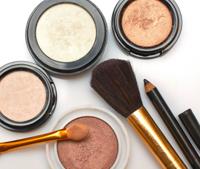 Keeping cosmetics clean seems like an easy concept to grasp, yes? But look around … Got globs in your mascara wand? Still wearing a lipstick you bought a year ago? Is your liquid foundation separating?
Keeping cosmetics clean seems like an easy concept to grasp, yes? But look around … Got globs in your mascara wand? Still wearing a lipstick you bought a year ago? Is your liquid foundation separating?
It sounds as though a trip to the cosmetics counter is long overdue. While it might not be in your budget, a freshening up of makeup might well save you money later on by preventing a nasty, potentially dangerous infection now.
Old make-up containers have been shown to harbor all kinds of bacteria. While a good many cosmetics contain preservatives to prevent the growth of bacteria, the older the product, the weaker the preservative.
And the more a product has been used, the higher the likelihood that there’s bacterial growth.
“Most women do have a drawer full of cosmetics that have been partially used,” says Angela Bowers, M.D., dermatologist on the medical staff at Baylor Regional Medical Center at Grapevine. But knowing when a cosmetic has reached a danger point isn’t always easy to pinpoint as they usually don’t have expiration dates, she says.
One way to monitor product safety is to take note of the date you first opened it. Keep a special calendar or, if possible, mark the date on the product with a permanent marker.
Cosmetics with the least shelf life are eye makeups such as mascara, eye shadow and liner. These should be replaced after just three months.
“The bacteria can get in there and the preservatives might not be working quite as well as they were when you first opened it. If you get some of that in your eye, you may develop conjunctivitis, which we know as ‘pink-eye,'” explains Dr. Bowers.
Liquid foundations also should be disposed of after three months; any other kinds of non-liquid foundations, blushers and powders should be tossed after a year.
“Some women may develop a peri-oral dermatitis from using some old, expired makeup that might irritate the skin and cause little red bumps that look like acne,” adds Dr. Bowers.
It only makes sense that makeup applicators carry similar risks for infection.
“If you use sponges to apply makeup, you should replace those at least once a week,” says Dr. Bowers.
You can find affordable replacements at any drugstore. And don’t forget to buy a few new eye shadow brushes while you’re at it!
Here’s another safeguard to follow: Keep your cosmetics fresher by keeping them to yourself. In other words, no sharing! Lipsticks and glosses are especially notorious for providing the perfect avenue for transmitting such undesirables as herpes simplex (the virus that causes cold sores) and other icky infections. Keep in mind that a cold sore doesn’t have to be visible for herpes simplex to be present on the lips.
Staphylococcus aureus (staph, for short) is another culprit that often finds a home in the germ-friendly environment of old and shared cosmetics. This common bacterium can cause infections such as impetigo, says Dr. Bowers.
Another clue that a cosmetic is due for a change-out is the smell – any unusual odor is probably a signal that bacteria are growing there.
But sometimes using cosmetics is like a game of roulette. Recently, a large batch of mascara manufactured in Hong Kong was found to be harboring Candida albicans, which can cause yeast infections on the skin and mucous membranes. To address the problem, the International Organization for Standardization (ISO) developed a new set of guidelines for production of cosmetics.
How did the contaminant find its way into a brand new product?
According to Hong Kong’s Consumer Council, the “excessive microbial content” found in the mascara can be attributed to poor hygiene during production, damaged packaging, and either insufficient or defective preservatives.
While the U.S. maintains pretty strict regulations, other countries from which we receive goods don’t always follow similar guidelines. If possible, buy products that are manufactured in the U.S. Still, it’s not always easy to tell the origins of a cosmetic.
Here are some safety tips for cosmetic use provided by the U.S. Food and Drug Administration:
- Follow directions on the label carefully, including all “Cautions” and “Warnings.”
- Keep makeup closed tight when not in use.
- Wash your hands before you put on makeup.
- Do not put on makeup while you are driving.
- Do not share makeup with anyone else.
- Do not add liquid to makeup.
- Stop using a product if you get a rash or other problem where you are using it.
- Throw away makeup if the color changes.
- Throw away makeup if it gets an odor.
- Be extra careful not to keep mascara too long. Some companies say three months is long enough.
- Do not use eye makeup when you have an eye infection; throw away eye makeup you were using when you got the infection.
- Keep makeup out of the sun and heat.
And if you have an adverse reaction to a cosmetic — develop a rash, irritation or infection — see your doctor right away.
